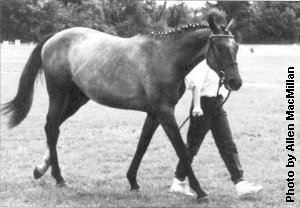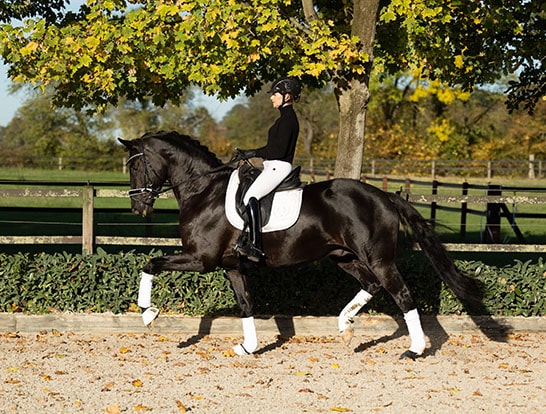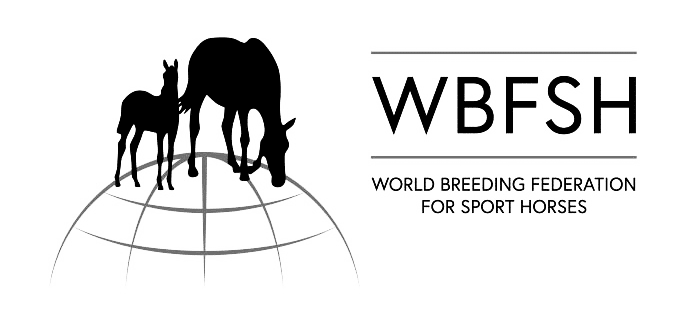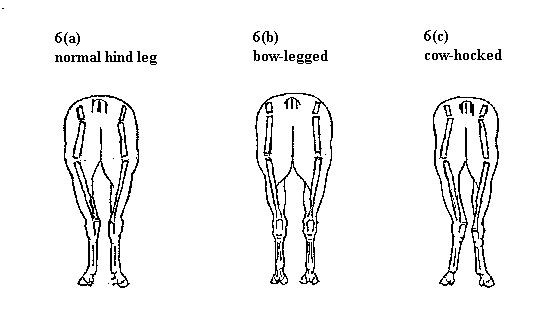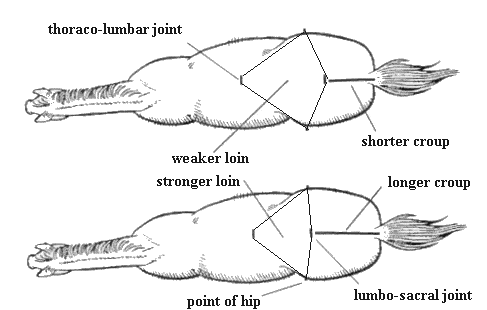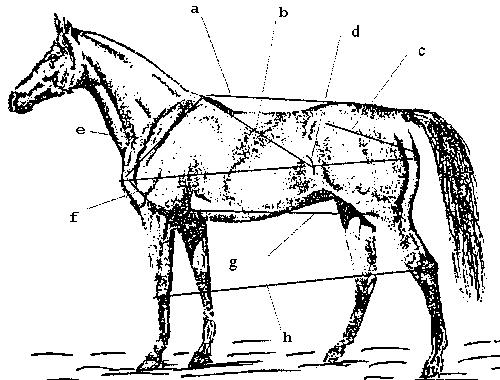by Lars Gehrmann
(Translated from Trakehner Hefte 4/97 as it appeared in the 1997 Fall issue of The American Trakehner)
We all know that stallions and mares are given marks when they are inspected – but what exactly to these marks represent? Here Lars Gehrmann, Trakehner Verband Breed Director, gives us the “official” definition of each.
1. Type
The mark for type makes a distinction between breed type and gender type. The breed type may vary within a range from coarse to very noble; with respect to its gender type, the horse should be either appropriately masculine or feminine in its appearance. Quite frequently one also sees the so-called “sexless” types, which are of course not so desirable.
The mark for type today is no longer characterized by the definition “appearance suitable for a certain use,” since the type of use is clearly a function of the breeding goal, the riding horse. The mark for type is determined by such criteria as expression, harmony and presence, and it must be considered that a beautiful head alone does not represent type. Nevertheless, because of the difficult definition of this criterion, the personal taste [of the inspector] may exert a great deal of influence on this mark, as it is indeed noted in practice. That is why this mark in particular is often subject of discussion in individual cases.
2. Frame
The mark for “frame,” more precisely, the upper body, is defined as “above the elbows and knee joints.” The features considered for this mark are, in particular, the head (including throatlatch and poll), the neck, that is, its attachment, its curve, and the development of its muscles, as well as the withers, shoulder and point of the shoulder. Also evaluated for this mark are the back, including saddle position and loins; the croup with the lower back muscles and the tail set; as well as the pelvic region. The term “top line” is often used in this connection. The frame, however, also includes the torso with the ribs and their curvature, that is, the depth and breadth of the chest cavity as well as the body’s proportions. When seen from the side, the division into forehand, midsection, and hindquarters, must be appropriately harmonious, that is uniform.
3. Legs
The criterion called legs is initially subdivided into foreleg and hind leg, with the foreleg including elbow, forearm, knee, cannon bone, pastern and hoof. The hind leg includes the stifle, thigh, hock, cannon bone, and also pastern and hoof.
The following incorrect positions are considered in the mark:
- The forelegs may toe in or toe out or may be bow-legged or knock-kneed. Seen from the front, they may be offset; and elbows that are pushed in are also undesirable.
- The hind legs, seen from behind, may also be toeing in or out, the legs may be bow-legged or cow-hocked.
- Seen from the side, one distinguishes between a foreleg that is camped out toward the front or back; and also between a foreleg that is over at the knee or calf-kneed, and between a foreleg that is cut out or tied in below the knee.
- In the hind leg, seen from the side, the angle of the hock (open, i.e., a wide angle, or a very acute angle) is considered as well as the shape of the hocks, which include a poorly set joint, a narrow hock, or a curby hock.
- The pastern may be long or steep and may exhibit the consequences of a clubfoot.
- The hoof itself, finally, may exhibit abnormalities in the direction toward a clubfoot or a contracted hoof. There are also uneven hooves and hooves that are too small for the body.
Incorrectness in movement, which also fall under the mark for the legs, are paddling in front, twisting hocks or fetlock joints behind. And then there are horses that step noticeably wide or narrow behind or in front.
4. The Walk
The walk should cover much ground and not be too short. Also, a lively and fluid walk is desirable, not a dragging walk. Another requirement for the walk is a light and elastic step in contrast to a walk that sticks to the ground and, finally, the walk must be a clean four-beat walk; this is an absolute prerequisite for a high mark for the walk. In addition to flaws in the beat, offset steps are also recorded as a deviation from the standard.
5. The Trot
The trot should cover much ground, that is, the forelegs should be put down where they point. A flat trot with little knee action is undesirable. Very important is the thrust from the hindquarters, that is , with energetic strides, which is equivalent to lifting of the hind legs, while shoving the hind legs forward during the motion phase of the trot is correspondingly criticized. Finally, the trot must be in a clear two-beat and must develop the appropriate swing and elasticity in the back as contrasted to a tight, board-like back, often with a tail that is carried high.
6. The Canter
The requirements for the canter are, in addition to a clearly defined three-beat, primarily a flowing, that is, elasticity springing sequence of movements in contrast to scraping, hurried and hasty movements. The canter must be composed of quiet jumping strides, and then of course it must also cover enough ground. A canter of short strides will be given a correspondingly negative evaluation.
In principle, all good marks for movement reflect the demonstration of an uphill tendency, while a downhill horse that falls onto its forehand will get lower marks. All basic paces must also show a swinging back (suppleness) and the horse must have the ability to step underneath the center of gravity of its own body. Neck and poll should not be stiff. The prerequisites of a clear beat, ground-covering strides, elasticity, manner, balance, and the power of the strides are given the correspondingly positive consideration in all basic paces.
7. General Impression
The last mark for general impression may be influenced by various factors. They include:
- a consideration of the previously given marks for conformation and movement;
- a consideration of criteria that are expressed only conditionally in the other marks (e.g., temperament, overall format, frame, fusion of body and legs);
- the significance with respect to athleticism (with consideration of any performance record of the horse) and, finally;
- the pedigree of the horse, for example with respect to its expected value for the breed.





